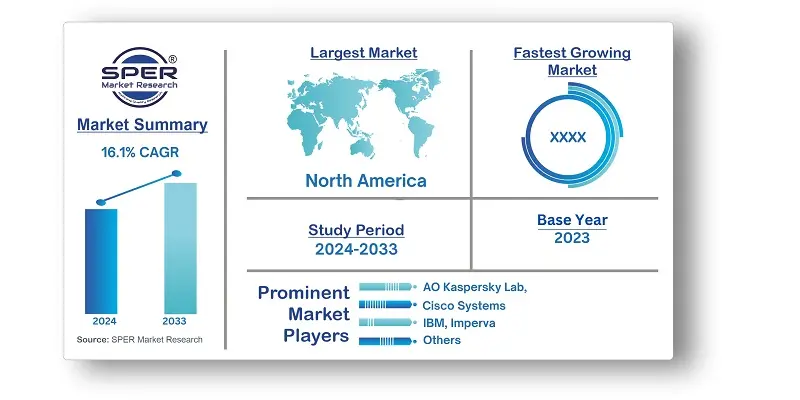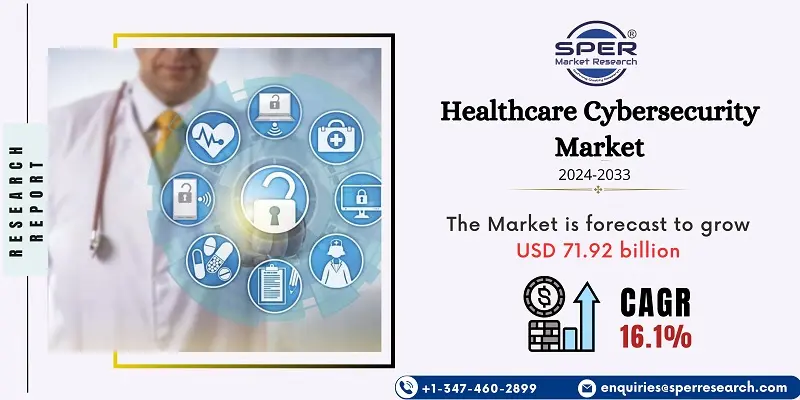
Healthcare Cybersecurity Market Growth, Size, Trends, Demand, Revenue and Future Outlook
Healthcare Cybersecurity Market Size- By Security Type, By Type of Threat, By End User- Regional Outlook, Competitive Strategies and Segment Forecast to 2033
| Published: Apr-2024 | Report ID: IACT2467 | Pages: 1 - 235 | Formats*: |
| Category : Information & Communications Technology | |||
- July 2022: Clearwater, a supplier of cyber risk management and HIPAA compliance solutions, purchased Tech Lock. This made it possible for the business to provide managed detection and response (MDR) services continuously. To detect and address cyber threats, the MDR system makes use of a unique security orchestration and response (SOAR) engine. In addition, Clearwater plans to use industry-certified assessors from Tech Lock to provide PCI, HITRUST, and CMMC exams and certifications.
- July 2022: Google Cloud became an ambassador partner of the Health Information Sharing and Analysis Centre (Health-ISAC) in order to collaborate with leaders in the industry to protect and safeguard the healthcare sector by utilising its vast resources and team of professionals. In response, Google established the Google Cybersecurity Action Team (GCAT), whose mission is to coordinate security resources with other resources in order to support the healthcare industry's efforts to improve cybersecurity.


| Report Metric | Details |
| Market size available for years | 2020-2033 |
| Base year considered | 2023 |
| Forecast period | 2024-2033 |
| Segments covered | By Security Type, By Type of Threat, By End User |
| Regions covered | North America, Asia-Pacific, Latin America, Middle East & Africa and Europe |
| Companies Covered | AO Kaspersky Lab, Cisco Systems, Inc., Fortinet, Inc., IBM, Imperva, Intel Corporation, Lockheed Martin Corporation, Marubeni Information Systems Co., Ltd., McAfee, LLC., Medigate (Claroty), Northrop Grumman, Symantec Corporation, Trend Micro Incorporated, Others |
- Hospitals and Healthcare Facilities
- Healthcare Providers (Doctors, Nurses, Clinics)
- Health Insurance Companies
- Pharmaceutical Companies
- Medical Device Manufacturers
- Healthcare IT Companies
- Government Healthcare Agencies
- Healthcare Regulators and Compliance Authorities
- Research Institutions and Universities
- Patients and Healthcare Consumers
- Others
| By Security Type: |
|
| By Type of Threat: |
|
| By End Use: |
|
- Global Healthcare Cybersecurity Market Size (FY’2024-FY’2033)
- Overview of Global Healthcare Cybersecurity Market
- Segmentation of Global Healthcare Cybersecurity Market By Security Type (Services, Solutions)
- Segmentation of Global Healthcare Cybersecurity Market By Type of Threat (Advanced Persistent Threat, DDoS, Lost or Stolen Devices, Malware, Spyware, Others)
- Segmentation of Global Healthcare Cybersecurity Market By End Use (Hospitals, Medical Devices, Payers, Pharmaceuticals, Others)
- Statistical Snap of Global Healthcare Cybersecurity Market
- Expansion Analysis of Global Healthcare Cybersecurity Market
- Problems and Obstacles in Global Healthcare Cybersecurity Market
- Competitive Landscape in the Global Healthcare Cybersecurity Market
- Impact of COVID-19 and Demonetization on Global Healthcare Cybersecurity Market
- Details on Current Investment in Global Healthcare Cybersecurity Market
- Competitive Analysis of Global Healthcare Cybersecurity Market
- Prominent Players in the Global Healthcare Cybersecurity Market
- SWOT Analysis of Global Healthcare Cybersecurity Market
- Global Healthcare Cybersecurity Market Future Outlook and Projections (FY’2024-FY’2033)
- Recommendations from Analyst
1.1. Scope of the report1.2. Market segment analysis
2.1. Research data source
2.1.1. Secondary Data2.1.2. Primary Data2.1.3. SPER’s internal database2.1.4. Premium insight from KOL’s
2.2. Market size estimation
2.2.1. Top-down and Bottom-up approach
2.3. Data triangulation
4.1. Driver, Restraint, Opportunity and Challenges analysis
4.1.1. Drivers4.1.2. Restraints4.1.3. Opportunities4.1.4. Challenges
4.2. COVID-19 Impacts of the Global Healthcare Cybersecurity Market
5.1. SWOT Analysis
5.1.1. Strengths5.1.2. Weaknesses5.1.3. Opportunities5.1.4. Threats
5.2. PESTEL Analysis
5.2.1. Political Landscape5.2.2. Economic Landscape5.2.3. Social Landscape5.2.4. Technological Landscape5.2.5. Environmental Landscape5.2.6. Legal Landscape
5.3. PORTER’s Five Forces
5.3.1. Bargaining power of suppliers5.3.2. Bargaining power of buyers5.3.3. Threat of Substitute5.3.4. Threat of new entrant5.3.5. Competitive rivalry
5.4. Heat Map Analysis
6.1. Global Healthcare Cybersecurity Market Manufacturing Base Distribution, Sales Area, Product Type6.2. Mergers & Acquisitions, Partnerships, Product Launch, and Collaboration in Global Healthcare Cybersecurity Market
7.1. Global Healthcare Cybersecurity Market Value Share and Forecast, By Security Type, 2024-20337.2. Services7.3. Solutions
7.3.1. Antivirus and Antimalware7.3.2. DDoS Mitigation7.3.3. Identity and Access Management7.3.4. Intrusion Detection System/ Intrusion Prevention System7.3.5. Risk and Compliance Management7.3.6. Security Information and Event Management
8.1. Global Healthcare Cybersecurity Market Value Share and Forecast, By Type of Threat, 2024-20338.2. Advanced Persistent Threat8.3. DDoS8.4. Lost or Stolen Devices8.5. Malware8.6. Spyware
8.7. Others
9.1. Global Healthcare Cybersecurity Market Value Share and Forecast, By End Use, 2024-20339.2. Hospitals9.3. Medical Devices9.4. Payers9.5. Pharmaceuticals9.6. Others
10.1. Global Healthcare Cybersecurity Market Size and Market Share
11.1. Global Healthcare Cybersecurity Market Size and Market Share By Security Type (2020-2026)11.2. Global Healthcare Cybersecurity Market Size and Market Share By Security Type (2027-2033)
12.1. Global Healthcare Cybersecurity Market Size and Market Share By Type of Threat (2020-2026)12.2. Global Healthcare Cybersecurity Market Size and Market Share By Type of Threat (2027-2033)
13.1. Global Healthcare Cybersecurity Market Size and Market Share By End Use (2020-2026)13.2. Global Healthcare Cybersecurity Market Size and Market Share By End Use (2027-2033)
14.1. Global Healthcare Cybersecurity Market Size and Market Share By Region (2020-2026)14.2. Global Healthcare Cybersecurity Market Size and Market Share By Region (2027-2033)14.3. Asia-Pacific
14.3.1. Australia14.3.2. China14.3.3. India14.3.4. Japan14.3.5. South Korea14.3.6. Rest of Asia-Pacific
14.4. Europe
14.4.1. France14.4.2. Germany14.4.3. Italy14.4.4. Spain14.4.5. United Kingdom14.4.6. Rest of Europe
14.5. Middle East and Africa
14.5.1. Kingdom of Saudi Arabia14.5.2. United Arab Emirates14.5.3. Rest of Middle East & Africa
14.6. North America
14.6.1. Canada14.6.2. Mexico14.6.3. United States
14.7. Latin America
14.7.1. Argentina14.7.2. Brazil14.7.3. Rest of Latin America
15.1. AO Kaspersky Lab
15.1.1. Company details15.1.2. Financial outlook15.1.3. Product summary15.1.4. Recent developments
15.2. Cisco Systems, Inc
15.2.1. Company details15.2.2. Financial outlook15.2.3. Product summary15.2.4. Recent developments
15.3. Fortinet, Inc
15.3.1. Company details15.3.2. Financial outlook15.3.3. Product summary15.3.4. Recent developments
15.4. IBM Corporation
15.4.1. Company details15.4.2. Financial outlook15.4.3. Product summary15.4.4. Recent developments
15.5. Imperva
15.5.1. Company details15.5.2. Financial outlook15.5.3. Product summary15.5.4. Recent developments
15.6. Intel Corporation
15.6.1. Company details15.6.2. Financial outlook15.6.3. Product summary15.6.4. Recent developments
15.7. Lockheed Martin Corporation
15.7.1. Company details15.7.2. Financial outlook15.7.3. Product summary15.7.4. Recent developments
15.8. Marubeni Information Systems Co., Ltd
15.8.1. Company details15.8.2. Financial outlook15.8.3. Product summary15.8.4. Recent developments
15.9. McAfee, LLC
15.9.1. Company details15.9.2. Financial outlook15.9.3. Product summary15.9.4. Recent developments
15.10. Medigate (Claroty)
15.10.1. Company details15.10.2. Financial outlook15.10.3. Product summary15.10.4. Recent developments
15.11. Northrop Grumman
15.11.1. Company details15.11.2. Financial outlook15.11.3. Product summary15.11.4. Recent developments
15.12. Symantec Corporation
15.12.1. Company details15.12.2. Financial outlook15.12.3. Product summary15.12.4. Recent developments
15.13. Trend Micro Incorporated
15.13.1. Company details15.13.2. Financial outlook15.13.3. Product summary15.13.4. Recent developments
SPER Market Research’s methodology uses great emphasis on primary research to ensure that the market intelligence insights are up to date, reliable and accurate. Primary interviews are done with players involved in each phase of a supply chain to analyze the market forecasting. The secondary research method is used to help you fully understand how the future markets and the spending patterns look likes.
The report is based on in-depth qualitative and quantitative analysis of the Product Market. The quantitative analysis involves the application of various projection and sampling techniques. The qualitative analysis involves primary interviews, surveys, and vendor briefings. The data gathered as a result of these processes are validated through experts opinion. Our research methodology entails an ideal mixture of primary and secondary initiatives.



Frequently Asked Questions About This Report
PLACE AN ORDER
Year End Discount
Sample Report
Pre-Purchase Inquiry
NEED CUSTOMIZATION?
Request CustomizationCALL OR EMAIL US
100% Secure Payment






Related Reports
Our Global Clients
Our data-driven insights have influenced the strategy of 200+ reputed companies across the globe.




















